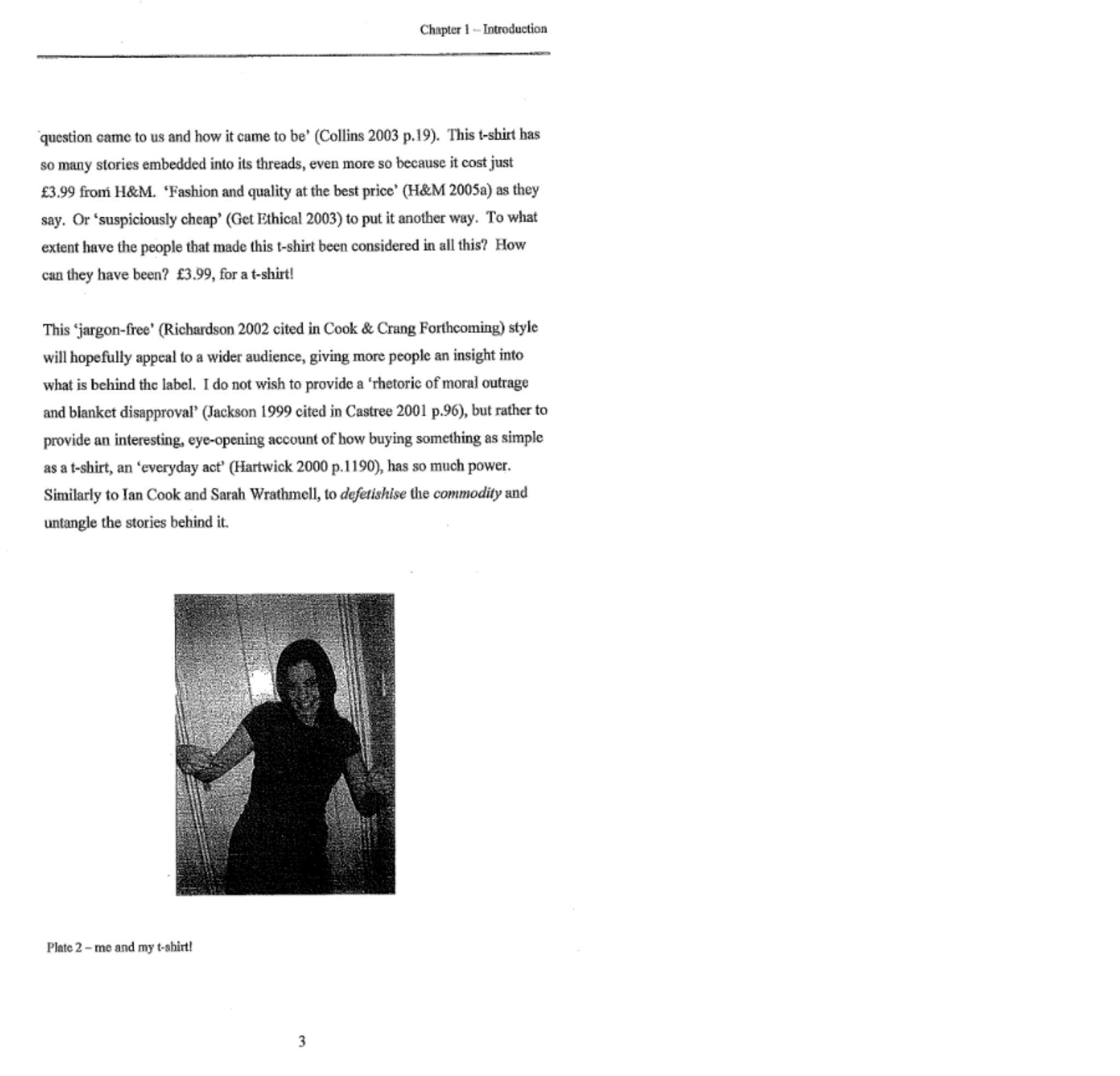
followthethings.com
Fashion
“Made in Cambodia“
A dissertation by Helen Clare, submitted as part of their BA Geography degree at the University of Birmingham, UK.
Click the preview pages above to read the dissertation.
Undergraduate student Helen Clare looks through her clothes and finds an H&M t-shirt ‘Made in Cambodia’. She’s traveling to Cambodia to do some charity work in her summer vacation. She wants to find and meet one of the garment factory workers who helped to make that T-shirt for her. But, despite her best efforts, she cannot gain access to the factories where she’s convinced it may have been made. So, she does the next best thing. She takes a course that will give her the qualification to work there. What does she learn along the way? Who does she get to meet? And what can she learn from them about the lives her t-shirt connects?
Dissertation reference: Helen Clare (2006) Made in Cambodia. BA Geography Dissertation: University of Birmingham, UK (followthethings.com/madeincambodia.shtml last accessed <insert date here>)
Page reference: Helen Clare (2024) Made in Cambodia. followthethings.com/made-in-cambodia.shtml (last accessed <insert date here>)
Estimated reading time: 92 minutes.
4 comments
Inspiration / Technique / Process / Methodology

The [undergraduate dissertation] I read [before I did my research] was about people in Sri Lanka and England whose lives were connected through the tea trade [Wrathmell 2003 link]. It was amazing. It was so real, reading about the people she had gone and visited. You could imagine being there. It scared me quite a lot, actually. I thought, ‘could I do this?’ ‘Could I actually go somewhere and do this?’ (Source: Clare in Allsop et al 2010, p.7).

In Cambodia, I was treated as the rich western white-skinned girl. People thought I was too young to be travelling on my own. People would say, ‘Your parents are OK with you coming out here? Are you from a good family?’ When we visited a compound where some of the factory workers lived, it attracted almost the whole village. And there was this one lady who asked, ‘Could I come back to England with you? Could I be your servant?’ And I was like ‘Oh my God! We don’t have servants. I do my own washing. I clean my own house.’ And she just couldn’t understand it at all. It was seriously bizarre (Source: Clare in Allsop et al 2010, p.12).

…sometimes I couldn’t keep it in. I was so close to tears that it was obvious to everyone there. There was this guy who lived in this tiny house with his wife and daughter. His wife also worked in a garment factory. He came across and wanted to interrogate me about what I’d found out. Like, ‘How much do people get paid here?’ I did my best to answer his questions. We spoke through a translator and used very basic English. He started telling me about how he worked in his factory’s ironing department and sometimes had to work from seven in the morning until three the next afternoon. He told me that they got a little package of rice to keep them going through the night. Then he said that sometimes he’d be so tired he’d iron over his hand. And he was smiling when he said it. His daughter was running around outside. She was peering in at me and my friend. She was so intrigued by us. And then he told me that he can’t afford to send her to school. It was just so real. The initial aim of my research was to identify the people in Cambodia who had made my t-shirt. But it turned out more that I was identifying with them. That turned out to be a big theme in my dissertation (Source: Clare in Allsop et al 2010, p.13-14).

[My dissertation] was totally ‘biased’. But then, hopefully, the people marking it can understand that ‘bias’ because I was there, experiencing those things. What I said was backed up by everything I saw. That’s why I think what I think. It’s situated knowledge. You don’t have to like it. Just read it. (Source: Clare in Allsop et al 2010, p.16).
Page compiled by Ian Cook et al (last updated August 2024). Dissertation downloadable with permission of author.
Sources
Allsop, D., Allen, H., Clare, H., Cook, I.J., Raxter, H., Upton, C., & Williams, A. (2010). Ethnography & participant observation. In Gomez, B. & Jones, JPJ III (eds) Research Methods in Geography: a Critical Introduction, Oxford: Wiley-Blackwell (download draft at http://followthethings.files.wordpress.com/2010/09/allsop-et-al-ethnography.pdf)
Image credit
Speaking icon: Speaking (https://thenounproject.com/icon/speaking-5549886/) by M Faisal from Noun Project (CC BY 3.0) Modified August 2024


